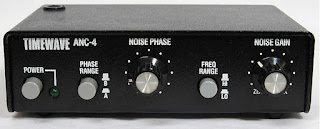Posts Tagged ‘VA7MM’
 MFJ / Timewave Noise Canceller Shootout
MFJ / Timewave Noise Canceller Shootout
A previous blog described a series of tests that Mark, VA7MM, performed demonstrating the effectiveness of his newly acquired MFJ- 1026 Noise Canceller.
He, along with Guy, VA7GI, recently had the opportunity to compare the performance of the MFJ against Guy's Timewave ANC-4.
I'll let Mark describe the results:
I'll let Mark describe the results:
NoiseCancellerShootout 2017 Report:
Guy Immega, VA7GI, and Mark Mattila, VA7MM, undertook side by side comparative tests of Timewave ANC-4 and MFJ-1026 noise cancellation gear (photos attached) by listening to interference at VA7MM in the HF spectrum between 7 MHz and 14 MHz. The program Spectran was used with the receiver on AM to adjust each unit for best performance and observe the relative performance of each. A system of coaxial relays was used to switch instantaneously between the units (photos attached).
Findings:
For practical purposes Timewave’s ANC-4 and MFJ’s 1026 are equal performers for eliminating interference in the HF spectrum.
Our findings corroborate the earlier findings of VE7CA that are posted on his website.
Switching the units in and out of noise was previously assessed on 40m CW, broadcast and raw noise. Examples of these tests are in a previous blogspot.
Commentary:
- main antenna in the tests was a multiband dipole at 30m above the ground.
- noise sense antenna was a Cushcraft R7 vertical antenna located 20m away from the main antenna.
- receiver was an Icom IC-746Pro.
- main antenna in the tests was a multiband dipole at 30m above the ground.
- noise sense antenna was a Cushcraft R7 vertical antenna located 20m away from the main antenna.
- receiver was an Icom IC-746Pro.
- both units tested have the same nulling capability.
- the preamp on the MFJ was found to be useful in certain instances for boosting the noise signal.
- in one test instance the Timewave unit produced intermod with AM broadcast leaking into the receiver when the noise gain was set near maximum.
- in instances where noise was coming from more than one direction, the filters could eliminate one noise source, or the other, but not both.
General Observations:
- the Timewave and MFJ filters have a learning curve to figure out how to quickly and precisely null out noise. A couple of evenings of tinkering was required to figure out how to use the unit with different noise sense antennas and different types of noise.
- the Timewave and MFJ filters have a learning curve to figure out how to quickly and precisely null out noise. A couple of evenings of tinkering was required to figure out how to use the unit with different noise sense antennas and different types of noise.
- the noise sense antenna is critical and must pick up a strong noise signal for the units to work effectively. In most instances for local interference at VA7MM the noise sense antenna is near the ground and vertically polarized and the main antenna is high above the ground and horizontally polarized.
- both noise amplitude and phase need to be alternately adjusted to attain a good null on the units.
- using Spectran or SDR with the receiver on AM helps in adjusting the units.
Next Steps:
- discussions are on combining the noise canceller with a small vertical plane receive loop on 160 or 80m. The idea is that the combination of the two could enable noise in two directions to be nulled. The receive loop would be pre-amplified.
- having two noise cancellers in series was also discussed as a means of nulling noise from two directions. An issue with this approach is that more processing electronics are put ahead of the front end of the receiver and this introduces its own noise and may create intermodulation.
- having two noise cancellers in series was also discussed as a means of nulling noise from two directions. An issue with this approach is that more processing electronics are put ahead of the front end of the receiver and this introduces its own noise and may create intermodulation.
- I like that the MFJ unit has gain controls for both the noise antenna and the main antenna. Other differences include MFJ providing both relay and RF sense T/R switching whereas the Timewave only has RF sense capability. The noise antenna connector on the MFJ is an SO-239which I find more practical than the RCA phono socket on the Timewave. As far as mechanical construction is concerned, the Timewave is more robustly built.
We’re open to any questions on these findings.
We’re open to any questions on these findings.
73,
Mark Mattila, VA7MM
Guy Immega, VA7GI
 MFJ / Timewave Noise Canceller Shootout
MFJ / Timewave Noise Canceller Shootout
A previous blog described a series of tests that Mark, VA7MM, performed demonstrating the effectiveness of his newly acquired MFJ- 1026 Noise Canceller.
He, along with Guy, VA7GI, recently had the opportunity to compare the performance of the MFJ against Guy's Timewave ANC-4.
I'll let Mark describe the results:
I'll let Mark describe the results:
NoiseCancellerShootout 2017 Report:
Guy Immega, VA7GI, and Mark Mattila, VA7MM, undertook side by side comparative tests of Timewave ANC-4 and MFJ-1026 noise cancellation gear (photos attached) by listening to interference at VA7MM in the HF spectrum between 7 MHz and 14 MHz. The program Spectran was used with the receiver on AM to adjust each unit for best performance and observe the relative performance of each. A system of coaxial relays was used to switch instantaneously between the units (photos attached).
Findings:
For practical purposes Timewave’s ANC-4 and MFJ’s 1026 are equal performers for eliminating interference in the HF spectrum.
Our findings corroborate the earlier findings of VE7CA that are posted on his website.
Switching the units in and out of noise was previously assessed on 40m CW, broadcast and raw noise. Examples of these tests are in a previous blogspot.
Commentary:
- main antenna in the tests was a multiband dipole at 30m above the ground.
- noise sense antenna was a Cushcraft R7 vertical antenna located 20m away from the main antenna.
- receiver was an Icom IC-746Pro.
- main antenna in the tests was a multiband dipole at 30m above the ground.
- noise sense antenna was a Cushcraft R7 vertical antenna located 20m away from the main antenna.
- receiver was an Icom IC-746Pro.
- both units tested have the same nulling capability.
- the preamp on the MFJ was found to be useful in certain instances for boosting the noise signal.
- in one test instance the Timewave unit produced intermod with AM broadcast leaking into the receiver when the noise gain was set near maximum.
- in instances where noise was coming from more than one direction, the filters could eliminate one noise source, or the other, but not both.
General Observations:
- the Timewave and MFJ filters have a learning curve to figure out how to quickly and precisely null out noise. A couple of evenings of tinkering was required to figure out how to use the unit with different noise sense antennas and different types of noise.
- the Timewave and MFJ filters have a learning curve to figure out how to quickly and precisely null out noise. A couple of evenings of tinkering was required to figure out how to use the unit with different noise sense antennas and different types of noise.
- the noise sense antenna is critical and must pick up a strong noise signal for the units to work effectively. In most instances for local interference at VA7MM the noise sense antenna is near the ground and vertically polarized and the main antenna is high above the ground and horizontally polarized.
- both noise amplitude and phase need to be alternately adjusted to attain a good null on the units.
- using Spectran or SDR with the receiver on AM helps in adjusting the units.
Next Steps:
- discussions are on combining the noise canceller with a small vertical plane receive loop on 160 or 80m. The idea is that the combination of the two could enable noise in two directions to be nulled. The receive loop would be pre-amplified.
- having two noise cancellers in series was also discussed as a means of nulling noise from two directions. An issue with this approach is that more processing electronics are put ahead of the front end of the receiver and this introduces its own noise and may create intermodulation.
- having two noise cancellers in series was also discussed as a means of nulling noise from two directions. An issue with this approach is that more processing electronics are put ahead of the front end of the receiver and this introduces its own noise and may create intermodulation.
- I like that the MFJ unit has gain controls for both the noise antenna and the main antenna. Other differences include MFJ providing both relay and RF sense T/R switching whereas the Timewave only has RF sense capability. The noise antenna connector on the MFJ is an SO-239which I find more practical than the RCA phono socket on the Timewave. As far as mechanical construction is concerned, the Timewave is more robustly built.
We’re open to any questions on these findings.
We’re open to any questions on these findings.
73,
Mark Mattila, VA7MM
Guy Immega, VA7GI
 MFJ-1026 Noise Canceller Tests At VA7MM
MFJ-1026 Noise Canceller Tests At VA7MM
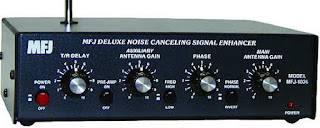 |
| courtesy: www.mfjenterprises.com/ |
Mark, VA7MM, has been testing out his newly-acquired MFJ-1026 Noise Canceller and has provided several videos of the noise canceller in action.
Like so many other hams, Mark's suburban location has seen a gradually rising noise floor and the noise heard in this video is from an off-site location within his local neighbourhood, located about 400m away.
The noise canceller requires a separate 'noise antenna' in order to cancel any noise on the main receiving antenna and for all of the tests shown below, Mark's noise antenna was a Cushcraft R-7 vertical while using an Icom IC-7600 transceiver for listening.
Test 1 shows the noise canceller being used while listening to a broadcast station on 6.0 MHz:
Test 2 shows the canceller's effect on raw noise while viewing in Spectran:
Test 3 shows the canceller's effect on a 40m CW signal:
Test 4 shows the effect of just the IC-7600's noise blanker on the offending noise:
Mark's comments:
Living in the noise cloud one must resort to special measures to use affected portions of spectrum. I recently purchased an MFJ-1026 noise canceller and have been testing the unit and have attached videos demonstrating the unit’s performance. You will see examples of raw noise, SW broadcast and 40 m CW signals with the unit being switched in and out. Also for comparison is the noise blanker in the IC-7600 failing to eliminate the same noise.
Conclusions:
- the unit is able to eliminate noise in most instances when adjusted properly
- the noise sense antenna is critical and several different switchable noise sense antennas may be required for good performance
- setting up on AM mode with Spectran helps with fine adjustment
- it outperforms the radio’s noise blanker in all cases tested
With proper tuning and set up, it looks like the MFJ-1026 can make a worthwhile improvement in unwanted noise reduction. Mark will also be testing and comparing a Timewave ANC-4 Noise Canceller with the MFJ and any videos received will be published here.
 MFJ-1026 Noise Canceller Tests At VA7MM
MFJ-1026 Noise Canceller Tests At VA7MM
 |
| courtesy: www.mfjenterprises.com/ |
Mark, VA7MM, has been testing out his newly-acquired MFJ-1026 Noise Canceller and has provided several videos of the noise canceller in action.
Like so many other hams, Mark's suburban location has seen a gradually rising noise floor and the noise heard in this video is from an off-site location within his local neighbourhood, located about 400m away.
The noise canceller requires a separate 'noise antenna' in order to cancel any noise on the main receiving antenna and for all of the tests shown below, Mark's noise antenna was a Cushcraft R-7 vertical while using an Icom IC-7600 transceiver for listening.
Test 1 shows the noise canceller being used while listening to a broadcast station on 6.0 MHz:
Test 2 shows the canceller's effect on raw noise while viewing in Spectran:
Test 3 shows the canceller's effect on a 40m CW signal:
Test 4 shows the effect of just the IC-7600's noise blanker on the offending noise:
Mark's comments:
Living in the noise cloud one must resort to special measures to use affected portions of spectrum. I recently purchased an MFJ-1026 noise canceller and have been testing the unit and have attached videos demonstrating the unit’s performance. You will see examples of raw noise, SW broadcast and 40 m CW signals with the unit being switched in and out. Also for comparison is the noise blanker in the IC-7600 failing to eliminate the same noise.
Conclusions:
- the unit is able to eliminate noise in most instances when adjusted properly
- the noise sense antenna is critical and several different switchable noise sense antennas may be required for good performance
- setting up on AM mode with Spectran helps with fine adjustment
- it outperforms the radio’s noise blanker in all cases tested
With proper tuning and set up, it looks like the MFJ-1026 can make a worthwhile improvement in unwanted noise reduction. Mark will also be testing and comparing a Timewave ANC-4 Noise Canceller with the MFJ and any videos received will be published here.
 The Green Glow
The Green Glow

Recent emails from two friends brought new insight into a blog that I had been intending to do for some time.
As has been mentioned on more than one occasion, I discovered radio at the age of 10, after reading an article about shortwave-listening in a drugstore magazine. My father was able to rescue an old GE cathedral from grandpa's downtown barbershop, where it sat gathering dust for several years in the back room storage space. Fortunately, it immediately came to life when plugged in and soon after dad spent an afternoon scurrying about on the roof of our 3-story house in central Vancouver, my radio-adventures began.
As I recall, the first couple of weeks were spent listening to radiotelephone traffic between various tugboats and their dispatchers, in the 2 megacycle marine band. Initially it took me awhile to figure out what I was listening to but found it fascinating to hear the tugboats up and down the coast getting their daily marching orders.
It wasn't too much later that I discovered the international shortwave bands and I was soon keeping detailed logs of my catches and mailing for a coveted QSL. Friday nights were always special as it meant I could DX well into the night and not worry about having to get out of bed for school early the next morning. My 3rd floor bedroom shack was the true definition of 'warm and cozy' and a memory I will always cherish.
Up to this point I had yet to discover ham radio. I must have tuned across a few conversations on phone but evidently hadn't been too awestruck at what I had heard ... perhaps I didn't know what I was hearing or was unable to comprehend some of the expressions they were using or what they were talking about when describing their gear. For whatever reason, the ham radio 'trigger-event' had not yet transpired ... but it soon would.
By this time, I had moved upward, from the Boy Cubs to the Boy Scouts. I must explain that these activities were forced upon me by my parents and not something I particularly enjoyed, especially the midwinter camping trips that were always pouring rain or freezing. Again, from grandfather, I had been provided with an old, virtually uninsulated, WW1 sleeping bag, that wouldn't have kept anyone alive at the western front for longer than a week. These all too regular winter excursions to the rain forest were pure misery and if I wasn't freezing to death then my sleeping bag was usually getting soaked from the river of rain running through the tent ... most of these weekend outings were sleepless and left me feeling like a zombie for the next few days. But ... not every scouting experience was bad and in fact, it was a scouting event that would soon provide my ham-radio 'trigger'!
The opportunity arrived for those that wished, to visit a local 'ham station' to partake in some sort of 'on-the-air experience'. This would have been in 1958 and having been already familiar with shortwave radio, I immediately signed-on.
A few weeks later, about six of us found ourselves in the basement shack of Ernie Savage, VE7FB. Although a stranger to me, Ernie was a well known 75m phone traffic man and an ardent 75m mobile operator. Although he was only about five-foot two, Ernie was a powerhouse of a personality and most of us cowered quietly as Ernie tweaked the dials and with a tight grip on his large microphone, barked louder than his small stature might suggest ... all of us quietly prayed that Ernie wouldn't pass the microphone to any of us.
And then I saw it! Although I didn't know it at the time, it was a pivotal moment in my development and would shape all aspects of my life from that point forward.
| courtesy: Paul's Tube Radio Restorations |
 |
| Heathkit VF-1 VFO Dial |
Perhaps the Heathkit engineers had learned of the 'power of green' from those earlier genius Hallicrafter's draftsmen ... can anyone deny the alluring appeal of a Hallicrafter's front panel or dial?
 |
| Hallicrafters SX-42 Dial |
As a young teen, I could never afford to buy a DX-100 but I was able to buy a VF-1 and added one to my Heathkit DX-20 magic transporter. With the lights turned off in the high attic bedroom shack, the orange dials of the Super Pro and its backlit S-meter combined with the seductive green glow of the VF-1. It just couldn't get any better!
Until recently, I had no real idea of why I had found the green dials so enchanting but an email from Mark, VA7MM, finally made it all perfectly clear. Mark offered the most plausible explanation ... the diabolical Heathkit and Hallicrafters engineers had been putting Kryptonite in their dials ... the stuff that even Superman found overpowering and unable to resist!
 |
| Powerless |
 The Green Glow
The Green Glow

Recent emails from two friends brought new insight into a blog that I had been intending to do for some time.
As has been mentioned on more than one occasion, I discovered radio at the age of 10, after reading an article about shortwave-listening in a drugstore magazine. My father was able to rescue an old GE cathedral from grandpa's downtown barbershop, where it sat gathering dust for several years in the back room storage space. Fortunately, it immediately came to life when plugged in and soon after dad spent an afternoon scurrying about on the roof of our 3-story house in central Vancouver, my radio-adventures began.
As I recall, the first couple of weeks were spent listening to radiotelephone traffic between various tugboats and their dispatchers, in the 2 megacycle marine band. Initially it took me awhile to figure out what I was listening to but found it fascinating to hear the tugboats up and down the coast getting their daily marching orders.
It wasn't too much later that I discovered the international shortwave bands and I was soon keeping detailed logs of my catches and mailing for a coveted QSL. Friday nights were always special as it meant I could DX well into the night and not worry about having to get out of bed for school early the next morning. My 3rd floor bedroom shack was the true definition of 'warm and cozy' and a memory I will always cherish.
Up to this point I had yet to discover ham radio. I must have tuned across a few conversations on phone but evidently hadn't been too awestruck at what I had heard ... perhaps I didn't know what I was hearing or was unable to comprehend some of the expressions they were using or what they were talking about when describing their gear. For whatever reason, the ham radio 'trigger-event' had not yet transpired ... but it soon would.
By this time, I had moved upward, from the Boy Cubs to the Boy Scouts. I must explain that these activities were forced upon me by my parents and not something I particularly enjoyed, especially the midwinter camping trips that were always pouring rain or freezing. Again, from grandfather, I had been provided with an old, virtually uninsulated, WW1 sleeping bag, that wouldn't have kept anyone alive at the western front for longer than a week. These all too regular winter excursions to the rain forest were pure misery and if I wasn't freezing to death then my sleeping bag was usually getting soaked from the river of rain running through the tent ... most of these weekend outings were sleepless and left me feeling like a zombie for the next few days. But ... not every scouting experience was bad and in fact, it was a scouting event that would soon provide my ham-radio 'trigger'!
The opportunity arrived for those that wished, to visit a local 'ham station' to partake in some sort of 'on-the-air experience'. This would have been in 1958 and having been already familiar with shortwave radio, I immediately signed-on.
A few weeks later, about six of us found ourselves in the basement shack of Ernie Savage, VE7FB. Although a stranger to me, Ernie was a well known 75m phone traffic man and an ardent 75m mobile operator. Although he was only about five-foot two, Ernie was a powerhouse of a personality and most of us cowered quietly as Ernie tweaked the dials and with a tight grip on his large microphone, barked louder than his small stature might suggest ... all of us quietly prayed that Ernie wouldn't pass the microphone to any of us.
And then I saw it! Although I didn't know it at the time, it was a pivotal moment in my development and would shape all aspects of my life from that point forward.
| courtesy: Paul's Tube Radio Restorations |
 |
| Heathkit VF-1 VFO Dial |
Perhaps the Heathkit engineers had learned of the 'power of green' from those earlier genius Hallicrafter's draftsmen ... can anyone deny the alluring appeal of a Hallicrafter's front panel or dial?
 |
| Hallicrafters SX-42 Dial |
As a young teen, I could never afford to buy a DX-100 but I was able to buy a VF-1 and added one to my Heathkit DX-20 magic transporter. With the lights turned off in the high attic bedroom shack, the orange dials of the Super Pro and its backlit S-meter combined with the seductive green glow of the VF-1. It just couldn't get any better!
Until recently, I had no real idea of why I had found the green dials so enchanting but an email from Mark, VA7MM, finally made it all perfectly clear. Mark offered the most plausible explanation ... the diabolical Heathkit and Hallicrafters engineers had been putting Kryptonite in their dials ... the stuff that even Superman found overpowering and unable to resist!
 |
| Powerless |
 630m VK’s Light-Up North America
630m VK’s Light-Up North America
It seems that all of my blogspots of late have focused on 630m propagation ... but what has been happening down there recently has been both amazing and somewhat unexpected. With the growing number of active stations listening and transmitting, the band's propagation capabilities and mysteries are quickly revealing themselves.
Last night was a great example but perhaps the WSPRnet prop map illustrates this best.
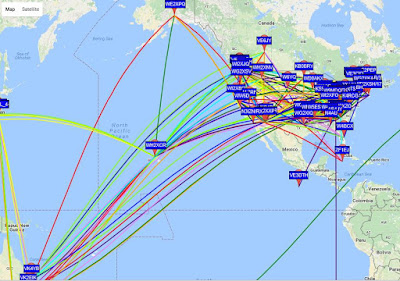 |
| courtesy: http://wsprnet.org/drupal/wsprnet/map |
Particularly striking was the long haul propagation from VK to North America, with northernmost VK4YB leading the pack. His 90 watt signal made it all the way to VE3IQB, near Ottawa as well as to NO3M, in Pennsylvania! To provide further hope to those that have little room for big receiving antennas, VE3IQB uses a typical small active e-probe antenna, 20' above ground!
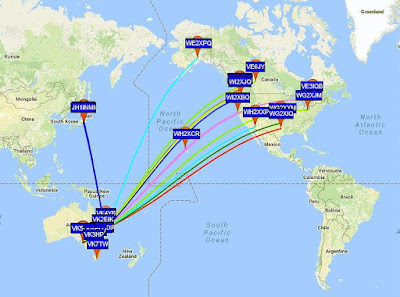 |
| courtesy: http://wsprnet.org/drupal/wsprnet/map |
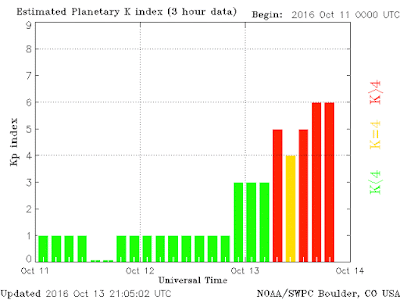 |
| courtesy: http://www.swpc.noaa.gov/ |
I'm theorizing that Roger's signal was arriving today at much lower angles than normal, evidenced by its far-reaching east coast reception and the fact that it couldn't get over my 600' local obstruction to the west. I've always believed that it takes higher angled signal arrival for me to hear Roger and today's events seem to support this.
Exactly what would cause this to be the case, I'll leave to the experts but I imagine that the sudden surge in geomagnetic activity played a significant role in today's very different propagation paths.
Roger was not the only VK lighting-up the map today. A much more detailed account of all the action can be found on the KB5NJD's daily 630m report here ... all very inspirational and hopefully enough to spur even more new activity on the MF band.
Why not give a listen and see what you can hear?
